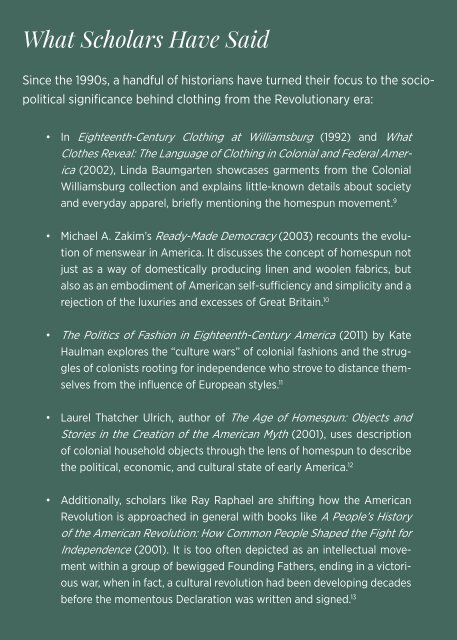The Fleece of Their Flock: Homespun & the American Identity
This interdisciplinary thesis project was researched, written, and designed by Jessica Vodnik and submitted in fulfillment of the Honors Senior Capstone requirement for the DePaul University Honors Program. Please do not copy, reproduce, or distribute without permission. Dr. Amy Tyson, Director, American Studies Dr. John Burton, Second Reader, History Undergraduate Honors Senior Thesis DePaul University, Chicago, IL May 10, 2015
This interdisciplinary thesis project was researched, written, and designed by Jessica Vodnik and submitted in fulfillment of the Honors Senior Capstone requirement for the DePaul University Honors Program. Please do not copy, reproduce, or distribute without permission.
Dr. Amy Tyson, Director, American Studies
Dr. John Burton, Second Reader, History
Undergraduate Honors Senior Thesis
DePaul University, Chicago, IL
May 10, 2015
You also want an ePaper? Increase the reach of your titles
YUMPU automatically turns print PDFs into web optimized ePapers that Google loves.
What Scholars Have Said<br />
Since <strong>the</strong> 1990s, a handful <strong>of</strong> historians have turned <strong>the</strong>ir focus to <strong>the</strong> sociopolitical<br />
significance behind clothing from <strong>the</strong> Revolutionary era:<br />
• In Eighteenth-Century Clothing at Williamsburg (1992) and What<br />
Clo<strong>the</strong>s Reveal: <strong>The</strong> Language <strong>of</strong> Clothing in Colonial and Federal America<br />
(2002), Linda Baumgarten showcases garments from <strong>the</strong> Colonial<br />
Williamsburg collection and explains little-known details about society<br />
and everyday apparel, briefly mentioning <strong>the</strong> homespun movement. 9<br />
• Michael A. Zakim’s Ready-Made Democracy (2003) recounts <strong>the</strong> evolution<br />
<strong>of</strong> menswear in America. It discusses <strong>the</strong> concept <strong>of</strong> homespun not<br />
just as a way <strong>of</strong> domestically producing linen and woolen fabrics, but<br />
also as an embodiment <strong>of</strong> <strong>American</strong> self-sufficiency and simplicity and a<br />
rejection <strong>of</strong> <strong>the</strong> luxuries and excesses <strong>of</strong> Great Britain. 10<br />
• <strong>The</strong> Politics <strong>of</strong> Fashion in Eighteenth-Century America (2011) by Kate<br />
Haulman explores <strong>the</strong> “culture wars” <strong>of</strong> colonial fashions and <strong>the</strong> struggles<br />
<strong>of</strong> colonists rooting for independence who strove to distance <strong>the</strong>mselves<br />
from <strong>the</strong> influence <strong>of</strong> European styles. 11<br />
• Laurel Thatcher Ulrich, author <strong>of</strong> <strong>The</strong> Age <strong>of</strong> <strong>Homespun</strong>: Objects and<br />
Stories in <strong>the</strong> Creation <strong>of</strong> <strong>the</strong> <strong>American</strong> Myth (2001), uses description<br />
<strong>of</strong> colonial household objects through <strong>the</strong> lens <strong>of</strong> homespun to describe<br />
<strong>the</strong> political, economic, and cultural state <strong>of</strong> early America. 12<br />
• Additionally, scholars like Ray Raphael are shifting how <strong>the</strong> <strong>American</strong><br />
Revolution is approached in general with books like A People’s History<br />
<strong>of</strong> <strong>the</strong> <strong>American</strong> Revolution: How Common People Shaped <strong>the</strong> Fight for<br />
Independence (2001). It is too <strong>of</strong>ten depicted as an intellectual movement<br />
within a group <strong>of</strong> bewigged Founding Fa<strong>the</strong>rs, ending in a victorious<br />
war, when in fact, a cultural revolution had been developing decades<br />
before <strong>the</strong> momentous Declaration was written and signed. 13<br />
- 14 -


